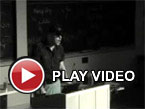Nicol Eltzroth Rosendorf, "Internal Return"
 I enjoyed Nicol Eltzroth Rosendorf's gnarled, doom-soaked debut Big Other (2020) quite a bit, but I enjoyed it in a casual way and failed to truly grasp the full extent of his singular and ambitious vision. While that situation has thankfully been remedied by this latest opus, the music of Internal Return is just one piece of a much larger and more complex ambition that incorporates Jewish tradition, artificial intelligence, video art, and a uniquely disturbing visual aesthetic that resembles a vivid sci-fi nightmare that blurs together several dystopian cinematic futures at once. Curiously, when taken by itself, the music of Internal Return is more elusive and ambiguous than its more crushing and epic predecessor. When combined with Rosendorf's AI-created videos, however, Internal Return transforms into a viscerally unsettling mindfuck that will probably haunt me for weeks. As Rosendorf himself puts it: "It is not a comfortable place to be in, at least not exactly; like being adrift in an imageless dream, it produces monsters of a kind that, once they are receding into memory, we get the sense they were not actually terrifying, just... strange." Hopefully, those monsters will recede into memory for me soon, as I am still very much lingering in the "terrified" stage for now.
I enjoyed Nicol Eltzroth Rosendorf's gnarled, doom-soaked debut Big Other (2020) quite a bit, but I enjoyed it in a casual way and failed to truly grasp the full extent of his singular and ambitious vision. While that situation has thankfully been remedied by this latest opus, the music of Internal Return is just one piece of a much larger and more complex ambition that incorporates Jewish tradition, artificial intelligence, video art, and a uniquely disturbing visual aesthetic that resembles a vivid sci-fi nightmare that blurs together several dystopian cinematic futures at once. Curiously, when taken by itself, the music of Internal Return is more elusive and ambiguous than its more crushing and epic predecessor. When combined with Rosendorf's AI-created videos, however, Internal Return transforms into a viscerally unsettling mindfuck that will probably haunt me for weeks. As Rosendorf himself puts it: "It is not a comfortable place to be in, at least not exactly; like being adrift in an imageless dream, it produces monsters of a kind that, once they are receding into memory, we get the sense they were not actually terrifying, just... strange." Hopefully, those monsters will recede into memory for me soon, as I am still very much lingering in the "terrified" stage for now.
As was the case with Big Other, Rosendorf enlisted an eclectic array of talented guests to help him realize his vision and Tzadik/Davka alum Daniel Hoffman kicks off the album with a fiery klezmer-informed violin solo over a roiling bed of doom-inspired drones. As Rosendorf sees it, Hoffman's violin acts as "a furious, yet frail guiding voice in a void" while "the music treads a path that you cannot follow, one that arbitrarily narrows down, twists and turns whenever you're certain you have it right." He also compares the underlying music to a series of depth charges and "an apocalypse in miniature," which sounds about right to me. Without the accompanying videos, Internal Return feels like being trapped in a crumbling and haunted fun house: it approximates a labyrinth of darkly surreal scenes that feel more like fleeting, enigmatic impressions than compositions with a deliberate dynamic arc or cathartic payoff. There is one exception, however, as the album's smoldering final drone epic ("Immer Besser") tags in Liturgy drummer Greg Fox for a ferociously volcanic crescendo of sludgy doom metal chords and machine-like blast beats. That piece is the closest thing that Internal Return has to a single, as the remaining pieces are too deconstructed to make a deep impact outside their intended context (musically, at least).
Within the context of the album, however, there are a number of other compelling pieces to be found. In particular, I am especially fond of some of Rosendorf's piano pieces, such as the understated noir jazz of "Shûb" (gradually consumed by a howling void) and the seething melancholy chamber music of "Heave" (ripped apart by a howling maelstrom of feedback). Elsewhere, the tender "Rückkehr" reprises the noir jazz mood of "Shûb," but uncharacteristically avoids being ripped apart, blown out, or otherwise ravaged and provides an unexpectedly pleasant late-album respite of sorts. Conversely, "Tacheles" is pure glorious ruin, landing somewhere between burning planes falling from the sky in extreme slow motion and the hull of a cavernous empty spaceship bending and warping as it is dragged into a black hole.
For me, however, Rosendorf's most striking and impressive achievement is "Wave Offering." On the album, it does not necessarily stand out all that much from the surrounding pieces (a gently undulating drone gets slowly consumed by a nightmarish squall of noise and distortion), but it becomes a mind-wrecking tour de force of psychotropic horror when combined with the accompanying video (shapeshifting fungal landscapes, grotesque hands, all-enveloping spore clouds, mysterious obelisks, eerie golden light, etc.). In fact, it feels more like an exceedingly dread-filled and prophetic dispatch from a (mostly) post-human future than a mere music video and Rosendorf impressively transforms AI-generated art's limitations into an asset, masterfully wielding the uncanny valley of the almost real for maximum unnerving discomfort. If I had seen that video in the middle of the night when I was an adolescent, I would probably still feel traumatized and unsettled by it today. Notably, that is not the case with most other sci-fi dystopias that I have encountered (aside from possibly the first two Alien films), so Rosendorf is definitely onto something wonderfully fucked up and profound with his disturbingly ungraspable and impressionistic nightmarescapes.



